I have over 30 years experience working in the travel and hospitality industry. I originally qualified as a chef, before moving into hotel management and the travel industry - working in Austria, France, Greece, Morocco, Colombia, Spain and her islands. Having worked in a variety of positions, in many European countries and Latin America, for both mass market and specialist operators - I have a well rounded background and understand the varying needs of my clients. It comes natural to me to try that little more, to offer better than the rest – a philosophy which became second nature whilst working for up-market companies like Lotus Supertravel Ski and Simply Travel. Whilst still living in London I was a founding Director of Simpson Travel and was instrumental in hand picking their portfolio of properties for their programme of distinctive villas and charming hotels in Andalucía, Mallorca and Morocco.
In 2004 we moved permanently to Andalucía where a month later our daughter Lily-Ana was born in Málaga. In 2006 our son, Oliver-Tomás, was born in Jerez and where our youngest daughter Sofia-Rose was also born in 2010; we live permanently in Medina Sidonia where our bilingual children are at the local schools. Having established our family in western Andalucía – leisure days are spent enjoying the endless beaches, the cultural treasures of the cities, the rural splendour of the national parks under blue skies and warm sunshine. I am fully aware that to maintain a positive future in Spain depends on loyal clients enjoying a wonderful holiday and wanting to return or better still recommending Andalucía Hideaways to all their friends and family.
I have not only visited each property but have stayed in each on at least one occasion – I could not ‘be better qualified to help guests make an informed decision when booking their holiday. People work so hard nowadays, that they can recoup their energies and enjoy a relaxing holiday environment is hugely rewarding - this is not just a job, but a way of life!
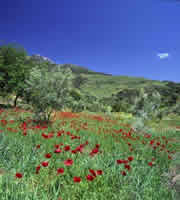 If we had to choose one word to describe this autonomous region of southern Spain – it would have to be diversity.
If we had to choose one word to describe this autonomous region of southern Spain – it would have to be diversity.
The eight provinces which make up Andalucia offer a wealth of diverse attractions, meeting the needs of almost every traveller.
Winter-sports enthusiasts can enjoy the snowy peaks of Mulhacen and Veleta, the highest mountains on mainland Spain.
Golfers are spoilt for choice – enjoying the established, world famous courses of Valderrama and Sotogrande along with the new kid on the block - Arcos Gardens, which is setting the standards for golfers in the new millennium.
Walking, hiking, cycling, canyoning, ballooning and paragliding are just some of the attractions you can enjoy in the 24 natural parks and 2 national parks.
These parks also offer diverse cross section of flora and fauna, and are home to a variety of wildlife including eagles, vultures, deer and the Iberian lynx.
And for those looking for history, art and culture – then the majestic city of Granada, along with Cordoba, Seville, Ronda, Jerez and Cadiz are all waiting to be discovered.
Undeniably, many of the coastal areas have been irretrievably damaged by over development - this is true for much of the coast from Almería in the east to Algeciras in the west. Fortunately, the most beautiful beaches of the south coast which run west from the Windsurf and Kite-surf capital of Europe – Tarifa, to the Portuguese border have escaped mass market development and remain remarkably undeveloped. What makes the beaches of this area so appealing is that in the most part they are backed by sand dunes and marshland, by dense pine forests, vast fields of sunflowers and rolling pastures.
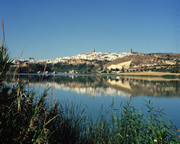 Arcos de la Frontera – one of Andalucía's most dramatically positioned pueblos blancos, straddling a rocky limestone ridge, its whitewashed houses and stone castle walls stop abruptly as the sheer cliff face plunges down to the fertile valley of the Rio Guadalete below. Justifiably popular with international visitors, the myriad of cobbled streets are some of the narrowest in Andalucía – not for the faint hearted!
Arcos de la Frontera – one of Andalucía's most dramatically positioned pueblos blancos, straddling a rocky limestone ridge, its whitewashed houses and stone castle walls stop abruptly as the sheer cliff face plunges down to the fertile valley of the Rio Guadalete below. Justifiably popular with international visitors, the myriad of cobbled streets are some of the narrowest in Andalucía – not for the faint hearted!
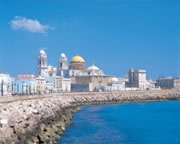 Cádiz - the oldest, continually inhabited city in Spain and possibly of western Europe. Sitting at the end of a narrow isthmus, surrounded by the Atlantic Ocean, Cádiz is understandably worth a least a day of your holiday time – with something for everyone to enjoy. The narrow streets connect into splendid plazas, sub-tropical gardens and a magnificent cathedral, Cádiz has several splendid beaches including La Caleta which served as the set for Cuban scenes in the James Bond movie - Die Another Day. In February, the city vibrates as it hosts one of the world’s greatest carnivals.
Cádiz - the oldest, continually inhabited city in Spain and possibly of western Europe. Sitting at the end of a narrow isthmus, surrounded by the Atlantic Ocean, Cádiz is understandably worth a least a day of your holiday time – with something for everyone to enjoy. The narrow streets connect into splendid plazas, sub-tropical gardens and a magnificent cathedral, Cádiz has several splendid beaches including La Caleta which served as the set for Cuban scenes in the James Bond movie - Die Another Day. In February, the city vibrates as it hosts one of the world’s greatest carnivals.  Conil de la Frontera – a characterful fishing port town with half a dozen great beaches. The majority of the Tuna caught here is shipped to Japan, where it is considered a highly prized delicacy. Conil throbs in July and August with mainly Spanish and a splattering of northern Europeans, enjoying the age old traditions of a typical beach holiday i.e. sea air, sandy beaches, the freshest of fish and a glass of something chilled.
Conil de la Frontera – a characterful fishing port town with half a dozen great beaches. The majority of the Tuna caught here is shipped to Japan, where it is considered a highly prized delicacy. Conil throbs in July and August with mainly Spanish and a splattering of northern Europeans, enjoying the age old traditions of a typical beach holiday i.e. sea air, sandy beaches, the freshest of fish and a glass of something chilled.
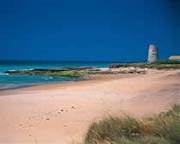 El Palmar – is arguably the best beach in the area and is also known locally as Vejer Costa. Popular with wave-surfers in the winter and kite-surfers in the summer, El Palmar has seven kilometres of golden-sand for those wishing to do little more than relax, read, eat, drink and doze. The string of houses, shops, bars and restaurants which have grown up behind the beach, combine to create a wonderfully, unsophisticated ‘village’ which attracts an incredibly loyal following. After an exhausting day of doing nothing, retire to Restaurante La Chanka for a sundowner and a superb fresh-fish supper – it’s as complicated as that.
El Palmar – is arguably the best beach in the area and is also known locally as Vejer Costa. Popular with wave-surfers in the winter and kite-surfers in the summer, El Palmar has seven kilometres of golden-sand for those wishing to do little more than relax, read, eat, drink and doze. The string of houses, shops, bars and restaurants which have grown up behind the beach, combine to create a wonderfully, unsophisticated ‘village’ which attracts an incredibly loyal following. After an exhausting day of doing nothing, retire to Restaurante La Chanka for a sundowner and a superb fresh-fish supper – it’s as complicated as that.
 El Puerto de Santa Maria – sat quietly between Jerez and Cádiz and often overlooked by foreign visitors to the area, El Puerto as it is known locally is a firm favourite with the Spanish – soaking up the warm sun, fresh fish, sherry, wines and the most controversial of Spanish pastimes bullfighting. As in much of Spain, the spring is buzzing with one fiesta after another and another attraction is the water-park, normally open from mid June to early September and especially popular at the weekends with families of all ages.
El Puerto de Santa Maria – sat quietly between Jerez and Cádiz and often overlooked by foreign visitors to the area, El Puerto as it is known locally is a firm favourite with the Spanish – soaking up the warm sun, fresh fish, sherry, wines and the most controversial of Spanish pastimes bullfighting. As in much of Spain, the spring is buzzing with one fiesta after another and another attraction is the water-park, normally open from mid June to early September and especially popular at the weekends with families of all ages.
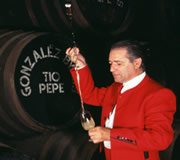 Jerez de la Frontera – home to the Royal Andalusian School of Equestrian Art, some of the worlds most famous Sherry Bodegas and is where Flamenco originated. The Fería de Mayo takes place in early May and is the most important celebration of the year when the Jerezanos turn out in force to celebrate their beloved horses, flamenco and sherry until the early hours of the morning. Jerez is also home to a small zoo, again making the city a great day out for all.
Jerez de la Frontera – home to the Royal Andalusian School of Equestrian Art, some of the worlds most famous Sherry Bodegas and is where Flamenco originated. The Fería de Mayo takes place in early May and is the most important celebration of the year when the Jerezanos turn out in force to celebrate their beloved horses, flamenco and sherry until the early hours of the morning. Jerez is also home to a small zoo, again making the city a great day out for all.
 Medina Sidonia – considered by many historians to be the oldest town in Europe, sits proudly at over 300m above sea level and enjoys panoramic views over rolling hills and the Atlantic Ocean to the Rif Mountains in Morocco. From the castle ruins and the Iglesia Mayor one can enjoy 360 degree vistas taking in La Sierra de Grazalama, Los Alcornocales Natural Park, Cadiz, Jerez, Arcos and Vejer de la Frontera – most of which are an easy half-hour’s drive away as are the stunning beaches of the nearby Costa de la Luz.
Medina Sidonia – considered by many historians to be the oldest town in Europe, sits proudly at over 300m above sea level and enjoys panoramic views over rolling hills and the Atlantic Ocean to the Rif Mountains in Morocco. From the castle ruins and the Iglesia Mayor one can enjoy 360 degree vistas taking in La Sierra de Grazalama, Los Alcornocales Natural Park, Cadiz, Jerez, Arcos and Vejer de la Frontera – most of which are an easy half-hour’s drive away as are the stunning beaches of the nearby Costa de la Luz.
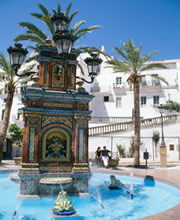 Vejer de la Frontera – one of the prettiest towns in the whole of Spain, gleams like Persil-white, sugar cubes or a ridge 200m above sea level. Cosmopolitan and yet steeped in tradition, it is easy to understand why bustling Vejer is the ‘Jewel in the Crown’ of the pueblos blancos in western Andalucía. Artisans peddle their wears to the wealth of visitors, whilst the restaurants vie for business with their mouth-watering menus and innovative locations - like La Castilleria in the nearby, verdant oasis of Santa Lucia.
Vejer de la Frontera – one of the prettiest towns in the whole of Spain, gleams like Persil-white, sugar cubes or a ridge 200m above sea level. Cosmopolitan and yet steeped in tradition, it is easy to understand why bustling Vejer is the ‘Jewel in the Crown’ of the pueblos blancos in western Andalucía. Artisans peddle their wears to the wealth of visitors, whilst the restaurants vie for business with their mouth-watering menus and innovative locations - like La Castilleria in the nearby, verdant oasis of Santa Lucia.
 Tarifa – wind and kite-surfing capital of Europe, where Africa meets Europe and the Atlantic meets the Mediterranean. This slightly bohemian port town bustles with the tanned and trendy enjoying the often brisk winds in the day and the laid-back nightlife once the sun has set. Popular with the children are the dolphin and whale watching boat trips, with all proceeds going towards the research and preservation of marine mammals. For a cultural twist, Tarifa is less than 45mins by hydrofoil from Tangiers – a popular daytrip for those wishing to sample the Moroccan hospitality.
Tarifa – wind and kite-surfing capital of Europe, where Africa meets Europe and the Atlantic meets the Mediterranean. This slightly bohemian port town bustles with the tanned and trendy enjoying the often brisk winds in the day and the laid-back nightlife once the sun has set. Popular with the children are the dolphin and whale watching boat trips, with all proceeds going towards the research and preservation of marine mammals. For a cultural twist, Tarifa is less than 45mins by hydrofoil from Tangiers – a popular daytrip for those wishing to sample the Moroccan hospitality.
 Seville – the stunningly beautiful capital of Andalucía and arguably one of the most picturesque cities in Spain, Seville is the ‘must see’ at least once during your stay. Seville captures the true ‘spirit of Spain’ and is a wonderful mixture of Roman, Muslim and Spanish architecture. The Alcazar for example, is a beautiful series of Moorish palaces, courtyards and gardens which rival the Alhambra in Granada whilst Seville’s Gothic cathedral, is the largest in Spain and retains the minaret of the mosque which it replaced.
Seville – the stunningly beautiful capital of Andalucía and arguably one of the most picturesque cities in Spain, Seville is the ‘must see’ at least once during your stay. Seville captures the true ‘spirit of Spain’ and is a wonderful mixture of Roman, Muslim and Spanish architecture. The Alcazar for example, is a beautiful series of Moorish palaces, courtyards and gardens which rival the Alhambra in Granada whilst Seville’s Gothic cathedral, is the largest in Spain and retains the minaret of the mosque which it replaced.
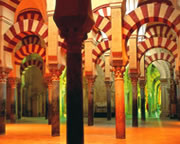 Córdoba – home to the magnificent Mesquita, the mosque dates back to the 8th century and sits in the centre of Córdoba, which has more than earned its title as a UNESCO World Heritage Sight. The first half of May hosts La Fería de los Patios - when hundreds of owners compete with their neighbours for the best floral display, and their private patios are open to all.
Córdoba – home to the magnificent Mesquita, the mosque dates back to the 8th century and sits in the centre of Córdoba, which has more than earned its title as a UNESCO World Heritage Sight. The first half of May hosts La Fería de los Patios - when hundreds of owners compete with their neighbours for the best floral display, and their private patios are open to all.
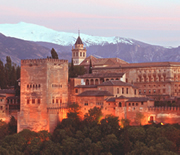 Granada – enjoys a backdrop of the often snow capped Sierra Nevada and is home to the world famous and majestic Alhambra Palace with the beautifully manicured Generalife Gardens. This thriving university-city buzzes with life, especially in the narrow streets teaming with tapas bars and Moroccan tea shops which lead off from La Plaza Nueva.
Granada – enjoys a backdrop of the often snow capped Sierra Nevada and is home to the world famous and majestic Alhambra Palace with the beautifully manicured Generalife Gardens. This thriving university-city buzzes with life, especially in the narrow streets teaming with tapas bars and Moroccan tea shops which lead off from La Plaza Nueva.
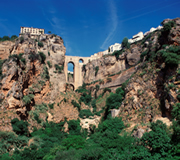 Ronda – spans the El Tajo canyon and offers magnificent views over the surrounding serranía. Home to Spain’s oldest bullring, present day Ronda now hums with day-trippers from the world over enjoying the picture perfect narrow streets, sunny plazas and mesmerising vistas. It is a pleasure driving to and from Ronda, winding through stunning mountain scenery, passing white-washed villages clinging to pine and olive clad slopes. And for a real treat, you can enjoy a memorable meal in the Michelin-starred Tragabuches restaurant – the first Michelin-starred restaurant in the whole of Andalucía.
Ronda – spans the El Tajo canyon and offers magnificent views over the surrounding serranía. Home to Spain’s oldest bullring, present day Ronda now hums with day-trippers from the world over enjoying the picture perfect narrow streets, sunny plazas and mesmerising vistas. It is a pleasure driving to and from Ronda, winding through stunning mountain scenery, passing white-washed villages clinging to pine and olive clad slopes. And for a real treat, you can enjoy a memorable meal in the Michelin-starred Tragabuches restaurant – the first Michelin-starred restaurant in the whole of Andalucía.
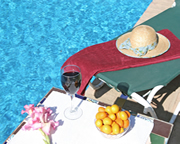 Málaga – not just an airport, but an important and attractive port city dating back to 1000 years BC. Attractions include the Cathedral, Roman Theatre and Alcazaba, along with several museums including the recently inaugurated Picasso Museum.
Málaga – not just an airport, but an important and attractive port city dating back to 1000 years BC. Attractions include the Cathedral, Roman Theatre and Alcazaba, along with several museums including the recently inaugurated Picasso Museum.
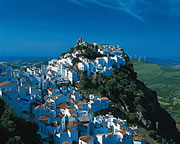 Casares – a picture perfect village in a spectacular setting. Just inland from the ‘delights’ of the nearby Costa del Sol – the brilliant white houses, cling to a rocky outcrop and are festooned with flower potted balconies and higgledy-piggledy roofs. Just half and hour from the golf-courses and bright lights of Sotogrande, Casares offers white-washed village charm in a dramatic location.
Casares – a picture perfect village in a spectacular setting. Just inland from the ‘delights’ of the nearby Costa del Sol – the brilliant white houses, cling to a rocky outcrop and are festooned with flower potted balconies and higgledy-piggledy roofs. Just half and hour from the golf-courses and bright lights of Sotogrande, Casares offers white-washed village charm in a dramatic location.
 Gaucín – perched at 600m above sea-level and almost equal distance between Ronda and the Costa del Sol, has long been popular with those looking for a mountain based retreat and views to the Mediterranean, Gibraltar and the Rif Mountains in Morocco. Along with the Spanish locals, there is an eclectic ex-pat community, both or which are more than catered for in the numerous tapas bars and international restaurants - giving this village a unique atmosphere.
Gaucín – perched at 600m above sea-level and almost equal distance between Ronda and the Costa del Sol, has long been popular with those looking for a mountain based retreat and views to the Mediterranean, Gibraltar and the Rif Mountains in Morocco. Along with the Spanish locals, there is an eclectic ex-pat community, both or which are more than catered for in the numerous tapas bars and international restaurants - giving this village a unique atmosphere.
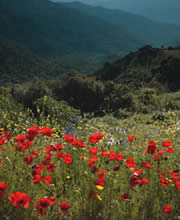 Jimena de la Frontera – hosts an International Music Festival in July, helping further establish this hill-top village as a popular destination for a growing international community and local Spanish alike. The castle dominates the town, from where you can enjoy privileged views over the neighbouring Alcornocales Natural Park. The local train trundles through the serranía to Ronda – an easy day-trip away, whilst in the other direction the line ends in Algeciras, from where you can enjoy a day visiting the souks of Tangiers in Morocco.
Jimena de la Frontera – hosts an International Music Festival in July, helping further establish this hill-top village as a popular destination for a growing international community and local Spanish alike. The castle dominates the town, from where you can enjoy privileged views over the neighbouring Alcornocales Natural Park. The local train trundles through the serranía to Ronda – an easy day-trip away, whilst in the other direction the line ends in Algeciras, from where you can enjoy a day visiting the souks of Tangiers in Morocco.
There is something for everyone in this land of diversity - Andalucía Hideways invites you to enjoy a side of Spain that you may well think disappeared many years ago – you would not be the first visitor to be very pleasantly surprised with what you find!